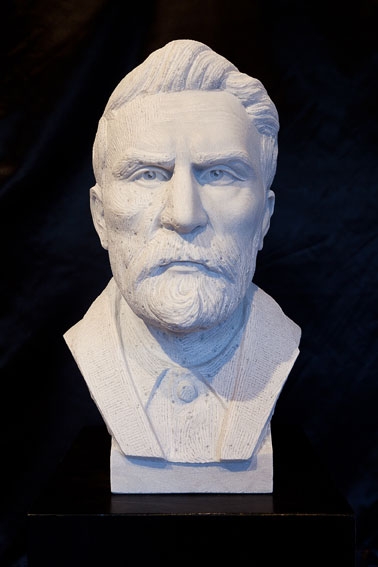In Carrara, the mountains seem covered by a perennial snowcap, even in summer. It’s an optical illusion: the white glow is that of its famous marble quarries, opened in the second century BC and still in use. Nowadays the extraction is done by heavy industrial machinery, so that the speed of consumption is traumatising. An endless flow of trucks runs up and down the winding roads, but not all the mineral is cut in slabs. Every day, tons of it are crushed and turned into the best powder in the world for whitening teeth, or to create ‘cultured marble’ when mixed with cement and resins – one of those insane Italian stories that can fill you with anger at the obtuseness of grinding up landscape, history and beauty for the sake of profit.
Of all the sculptures by Sam Durant installed in the Centro Arti Plastiche (Centre of Plastic Arts, a small museum, once a convent, overlooking the city) for this exhibition, the most poignant is possibly the most inconspicuous. Titled Calcium Carbonate (ideas spring from deeds and not the other way around) (2011; the title includes a quotation from nineteenth-century Italian revolutionary Carlo Pisacane), it is a carefully hand-sculpted marble reproduction of a bag of pulverised marble, resting on the floor. As if matter could revert to its original state, and time could be rewound. In counterpoint, one finds Black Powder (ours is a struggle inspired by love and not by hatred) (2011; here the quote is from anarchist Errico Malatesta’s Violence as a Social Factor, 1895), a marble copy of a box of explosives once used to set off the rocks – as well as for bombings. Carrara was the epicentre of anarchist thought and action in Italy, and the history of marble is inextricably linked with that of its defiant quarrymen. In Piazza Gramsci, visitors can come across a commemorative stone to a local hero, the anarchist trade unionist Alberto Meschi (1879–1958), ‘Maker of better times, magnificent worker among workers and outcasts, heart open to the wounds of man and society’.
Durant’s exhibition is the last chapter of Propaganda of the Deed, a project the California artist started two years ago, after he participated in Post-Monument, Carrara’s 14th Sculpture Biennale. The outcome of his site-specific research is a posthumous monument to legendary anarchists from the area, whose memory could be on the verge of vanishing together with the local handicrafts: Gino Lucetti, Renzo Novatore, Marie-Louise Berneri, Carlo Cafiero, Francesco Saverio Merlino and Malatesta. It consists of a series of marble busts, installed on high plinths against the background of a black (anarchy’s colour) flag held in place by a portable tubular structure. Previously exhibited at Galleria Franco Soffiantino in Turin and at MACRO in Rome, these black and white works revert to a less abstract, less remote state in Carrara, surrounded as they are by other marble sculptures from various editions of the biennale and a nostalgic aura of homecoming.
Durant commissioned the busts from a local atelier, Telara Studio d’Arte (he included in the captions the names of all the people who executed the heads), where old methods are still in use and the figure is firstly built in clay, then in plaster and finally in marble. As the portraits are based on old pictures, when the images are good, the rendering is detailed; when they are blurry, the busts are non-finito, left unfinished, and the traces of tecnica a punti (the use of compasslike instruments to measure the distance between different parts of the relief in plaster, in order to have the same measurements on the marble) become clearly visible. Curator Federica Forti’s decision also to include a series of didactic materials (books, photos, biographies of the protagonists, memoirs), as well as to reconstruct a (kitschy) corner of the production workshop, somehow closes the circle of cross-references and mimesis. What is historicised, what is fictionalised and what is ‘cultured’ mingle in the quietness of these rooms, open on the panorama of the self-consuming quarries.
This article was first published in the December 2013 issue.
